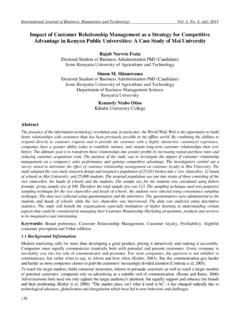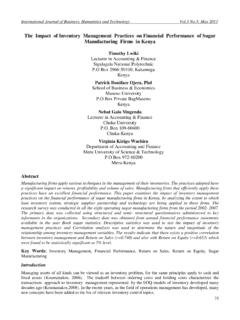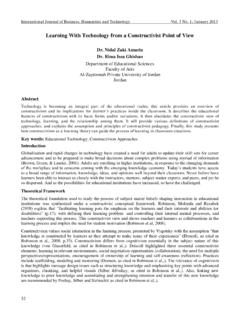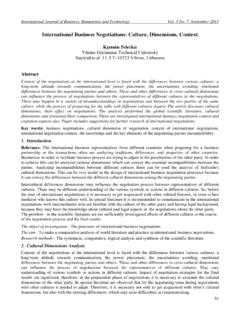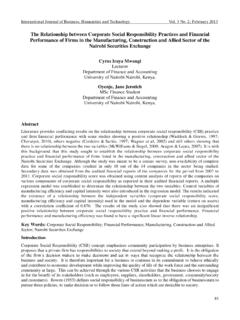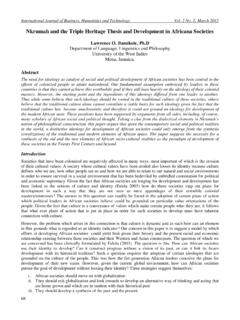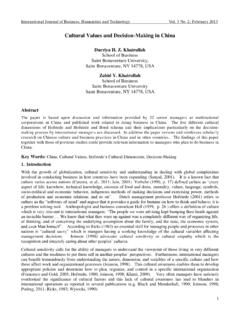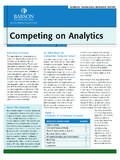Transcription of The Impact on the Operational Performance of World Class ...
1 International Journal of Business, Humanities and Technology Vol. 3 No. 8; December 2013. The Impact on the Operational Performance of World Class manufacturing strategies : A Company Application Ozlem Ipekgil Dogan Dokuz Eylul University Faculty of Economics and Administrative Sciences Dokuzcesmeler Campus 35160, Buca, Izmir Turkey Abstract Global commerce, rapidly-changing technologies and shortening product life-cycles, more and more, increase competition. Hence, most businesses face with considerable uncertainties and continual reformation, because the traditional approaches in production in our age are not sufficient enough. The Competitive environment today has considerably increased the interest in WCM that is World Class manufacturing which is defined as business practices that can provide competitive advantages worldwide by using manufacturing competence as a strategic tool. The WCM strategic implementations during the Operational performances were measured on the basis of Digalwar and Metri (2005) and Murugesan (2012) in a factory manufacturing plastic household textiles in zmir.
2 In addition, dimensions of WCM implementation were specified, the relationship between dimensions was studied in detail, and the results on the Operational performances were analyzed. Keywords: World Class manufacturing , WCM, Operational Performance 1. Introduction In the last three decades, the World has witnessed the emergence of effective forces which seek to reshape the economical and organizational communities, and has precipitated in the fundamental changes of the business strategy. These forces are represented by globalization, the emphasis on product and service quality, new technologies, changing economic and political structures, deregulations, and a new breed of sophisticated customers, who have changing requirements and expectations. These driving forces have lead individuals and organizations to appreciate the importance of World Class manufacturing -WCM (Digalwar and Sangwan, 2011).
3 Because the global competitors operating in global markets almost always tend to have World Class Performance (Saxena and Sahay, 2000),continuous improvement has become a necessity for the survival of businesses in a highly competitive environment in the World . Local competition gradually loses its validity, because even the farthest businesses are forced to compete with each other. For all the reasons, it is not enough to produce at required quality for businesses, they should also have an organized structure appropriate to the production system developed (IpekgilDoganet al., 2009). Many companies are coming to the realization that their survival depends on the capability to manage the production as a premier strategic function (Kasul and Motwani, 1995). In this context, WCM is a guide for businesses. In fact, as is the case with many other new concepts in management, there is no consistent definition of WCM.
4 The term World Class was coined by Hayes and Wheelwright (1984) to describe the capabilities which had been developed by some Japanese and German companies, as well as the US firms, which had competed equally with the Japanese and German firms. The term World Class manufacturing was used because these firms have achieved an outstanding Performance in their global competition, resulting in their being described as World Class (Eid, 2009). World Class manufacturing (WCM) was defined initially by Hayes and Wheelwright (1984) and Schonberger (1986) as a competitive strategy employing the best practices in quality, lean production, and concurrent engineering (Fullerton and McWatters, 2004). Schonberger (1986), developing the concept of WCM, focused on continuous improvement, adding the development of supplier relationships, product design and JIT. Gunn (1987) provides a strong emphasis on the role of technology in World Class manufacturing , while Hall (1983) stresses that World Class manufacturing is a fundamentally different way of operating an organization, rather than a set of techniques.
5 141. Center for Promoting Ideas, USA Giffi, Roth and Seal (1990) view quality and the customer as the primary focus of World Class manufacturing , supported by a combination of manufacturing strategy and capabilities, management approaches, organizational factors, human assets, technology and Performance measurement (Flynn et al., 1997). Hanson and Voss (1993). see World Class manufacturing in terms of practice and Performance . They define World Class as having best practice in total quality, concurrent engineering, lean production, manufacturing systems, logistics and organization and practice. In addition it is having Operational Performance equaling or surpassing best international companies (Voss, 1995). Although the words may be rearranged and appear differently, the message is fundamentally the same WCM is concerned with the competition between the best manufacturers in the World (Falah, 2003).
6 As a common philosophy focusing on production firstly, WCM includes more structural changes such as new production technologies, and both Just-In Time- JIT and Total Quality Management-TQM. WCM, changing attitudes and beliefs, provides a combination between responding rapidly to customer demands and a high degree of customer focus (Lind, 2001). WCM determines which set of activities needs to be undertaken by identifying what is needed by the companies in order to compete globally. Moreover, WCM itself involves many factors systematically related to promotion, for instance, raw materials, energy, machinery, labour and management. Furthermore, World Class companies optimize the problem-solving abilities of their employees in applying both modern techniques and traditional engineering process (Salaheldin and Eid, 2007). Being the best in the World at manufacturing , an obsolete product does not make an organization World Class .
7 Increasingly turbulent task environments, characterized by truncated product life cycles and segmented consumer markets, require World Class manufacturers to be flexible enough to satisfy changing market demands (Cook and Cook, 1994). WCM companies are those companies which continuously outperform the industry's global best practices, and intimately know their customers and suppliers as well as knowing their competitors' performances and knowing their own strengths and weaknesses. All of the qualities above form the basis of continually changing . competitive strategies and Performance objectives (Greene, 1991). Adopting effective management practices, capable of keeping pace with the changing technological environment, is particularly important to success in global markets. WCM requires continuous improvement because World standards constantly change (Cook and Cook, 1994). Companies engaged in WCM practices focus on improving operations, elimination of waste, managing customer relationships, creating lean organizations and implementing green practices, among others (Haleem et al.)
8 , 2012). World Class enterprises include both total quality and characteristics of learning organizations (Hodgettset al., 1994). Such improvements cannot be achieved with traditional methods. They require fundamentally rethinking and radically redesigning business processes and practices. This is the essence of World Class Performance (Kearney, 1997).Hence, partnering with an organization with World Class capabilities can offer access to new technology, tools and techniques that the organization may not currently possess; more structured methodologies, procedures and documentation; and a competitive advantage through expanded skills (Ghodeswar and Vaidyanathan, 2008). Effectively managing and measuring the product development process is widely seen as a means of ensuring business survival through reduced time to market, increased quality and reduced costs. There is usually very little information available to managers to guide them on introducing Performance measures to assist with product development (Driva et al.
9 , 1999). A problem which is common to attempts to define the concept of World Class manufacturing is how to interpret the measures within the operating context of the firm (Harrison, 1998). Literature on the Performance measures of World Class manufacturing is very limited. The only reason for this could be the fact that no single best practice framework exists for the implementation of World Class manufacturing principles, as each framework will necessitate the creation of different Performance measures. The only common factors that could be identified from the literature are cost, quality, and reliability/throughput. The main aim of World Class manufacturing is the pursuit of maximum efficiency for the production system in order to maximize the organization's profitability (Mey, 2011). 142. International Journal of Business, Humanities and Technology Vol. 3 No. 8; December 2013. WCM Implementation strategies For businesses in order to survive and be followed as the leader, they require having a structure that continuously learns and applies what is learnt.
10 The other values, businesses should have, include problem-solving, lean thinking, team working, loyalty, vivid participation and regular communication. WCM is the model that provides businesses to compete globally and systematically improve their power for competition on the base of these values above. An improvement in the road map way with well-defined paths is one of the most important tools to the success for all World Class manufacturers. Therefore, in order to achieve the objective of WCM model, some strategies ought to be evaluated within the concept of the continuous improvement. The strategies into WCM. models created by some researchers are tabulated in Table 1. The Effect of WCM Implementation strategies on the Operational Performance : A Company Application The Aim of the Study The main objective of the study is to investigate the effect of WCM implementation criteria on the Operational Performance .
